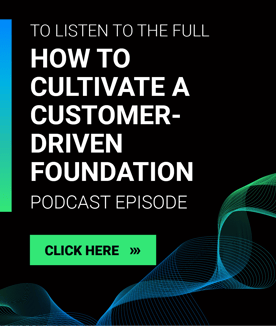How to Cultivate a Customer-Driven Foundation
Customer expectations have risen dramatically with an overwhelming 72% of customers sharing that they want immediate service from the companies they do business with. In response, organizations are challenged with living up to these heightened expectations to maintain and grow their business. To help brands gain deeper insight into the service journeys customers experience and whether they live up to what they expect, J.D. Power will publish our first-ever Cross-industry Customer Service Experience Study this fall. The study will gather and analyze Voice of the Customer feedback about the service interactions customers have had with over 100 brands across various industries.
As we prepare to publish these valuable insights, Denese Waiters, Director, Customer Service Advisory, and Omnichannel Practice Leader is hosting a podcast series to explore the state of customer service across the U.S. On this episode, she is joined by Annette Franz, Founder and CEO, CX Journey Inc., who has over 30 years of experience in the customer service industry. Together they discuss how organizations can build a customer-centric approach to increase satisfaction and what mistakes to avoid during this transition. The following is a recap of some key points in their conversation.
What is the importance of core values for an organization?
Establishing a strong cultural foundation with identifiable core values can have a profound impact on every aspect of your organization. To do this successfully, it’s crucial to establish clear and actionable guidelines for acceptable behavior and conduct. This will help guide future interactions with customers, partners, and among your team members.
Many companies underestimate the importance and impact of their core values. However, it is essential to incorporate these values into every aspect of the business. This involves recruiting individuals who resonate with the company's culture and evaluating, promoting, or even letting go of existing employees based on their alignment with these values. The values should also be ingrained into policies and procedures. Solidifying and reinforcing these values will not only have a lasting impact on the team, but customers will experience the long-term benefits of better experiences.
What is the difference between being customer-focused, customer-centric, and customer-obsessed?
While it may seem that being customer-focused, customer-centric, or customer-obsessed are all synonymous, there are crucial differences that set these terms apart.
Customer-focused
- In customer-focused organizations, most of the customer interactions are transactional and surface level, and service is not consistent across departments.
- Many organizations fail to understand their customers' wants and needs, resulting in missed opportunities to design and deliver great experiences that keep customers coming back.
Customer-centric
- Customers are at the core of all actions, decisions, and interactions within the organization.
- The voice of the customer is considered in every department during discussions, decisions, and designs.
- A customer-centric organization is focused on establishing relationships and creating a long-lasting impact.
Customer-obsessed
- This concept, coined by Jeff Bezos at Amazon, represents an unwavering and hyper-focused dedication to enhancing the customer experience.
- This idea of becoming customer-obsessed is often unattainable for many organizations. However, rather than striving for this elusive goal, companies should focus on creating customer-centric experiences that deliver lasting value.
What steps can companies take to become more customer-centric?
Organizations need to build a framework to create customer-centric employees. To build this foundation it’s necessary to focus on key principles such as:
- Culture is key: Creating a customer-centric culture is essential for your organization's success. By not only listening to the customer's voice in decision-making but also prioritizing their wants and needs, you can achieve higher levels of satisfaction.
- Commitment from leadership: For these ideas to become widely accepted, it is crucial for the CEO and executive members to make a strong commitment from the top down. There also needs to be an alignment among executives to ensure there is a clear consensus on allocated resources to foster a customer-centric culture.
- Mutual focus on employee and customer experiences: There is a strong correlation between employee and customer satisfaction. To enhance customer interactions, organizations need to put their employees first to create an environment where team members feel valued.
- Focus on understanding the customer: A deep understanding of customers’ wants and needs is crucial for delivering exceptional experiences. It’s truly the core of becoming customer-centric.
What mistakes do organizations make in the quest to become more customer-centric?
Along with culture issues and misalignment from leadership teams in attempting to become customer-centric, many organizations also run into the following challenges:
- Overreliance on technology to solve customer experience issues: Although technology can aid and create stronger customer interactions it doesn’t replace the human element in the customer experience.
- Lack of inconsistency across the organization: Not setting clear and understandable core values can create varying experiences across departments
Final Thoughts
As companies compete for customers’ business, it’s going to be crucial to set up a strong cultural foundation to meet ever-increasing customer expectations.
Listen to the episode below for more information about creating a customer-centric environment within your own organization and to learn more about Annette Franz’s background and newest book, “Built to Win”.
More about today’s speaker: Annette Franz, Founder and CEO, CX Journey Inc., has 30 years of experience (both client-side and vendor side) (a) helping companies understand their employees and customers, (b) identifying what drives retention, satisfaction, engagement, and the overall experience, and (c) designing employee and customer experience strategies to deliver a better experience for all constituents.
Share this
You May Also Like
These Related Stories

From Ordinary to Extraordinary, Creating Stand-Out Customer Experiences
.jpg?width=1920&height=1080&name=GBI%20Blog%20Image_The%20Future%20of%20Customer%20Service%201920x1080%20(4).jpg)
The Future of Customer Service: Top Trends that Can’t be Ignored


No Comments Yet
Let us know what you think